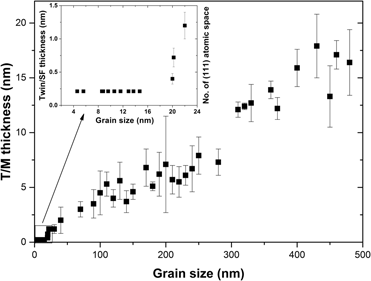Crossref Citations
This article has been cited by the following publications. This list is generated based on data provided by
Crossref.
Gao, Xuzhou
Dai, Liangjuan
and
Zhao, Yonghao
2020.
Twin boundary-dislocation interactions in nanocrystalline Cu-30% Zn alloys prepared by high pressure torsion.
Journal of Materials Research and Technology,
Vol. 9,
Issue. 5,
p.
11958.
Danard, Yolaine
Sun, Fan
Gloriant, Thierry
Freiherr Von Thüngen, Immanuel
Piellard, Michaël
and
Prima, Frédéric
2020.
The Influence of Twinning on the Strain–Hardenability in TRIP/TWIP Titanium Alloys: Role of Solute–Solution Strengthening.
Frontiers in Materials,
Vol. 7,
Issue. ,
Chen, Jie
Wei, Haiyang
Zhang, Xianfeng
Peng, Yong
Kong, Jian
and
Wang, Kehong
2021.
Flow behavior and microstructure evolution during dynamic deformation of 316 L stainless steel fabricated by wire and arc additive manufacturing.
Materials & Design,
Vol. 198,
Issue. ,
p.
109325.
Liu, Silu
and
Zhao, Yonghao
2021.
Revealing grain coarsening and detwinning in bimodal Cu under tension.
REVIEWS ON ADVANCED MATERIALS SCIENCE,
Vol. 60,
Issue. 1,
p.
15.
Bai, Yu
Kitamura, Hiroki
Gao, Si
Tian, Yanzhong
Park, Nokeun
Park, Myeong-heom
Adachi, Hiroki
Shibata, Akinobu
Sato, Masugu
Murayama, Mitsuhiro
and
Tsuji, Nobuhiro
2021.
Unique transition of yielding mechanism and unexpected activation of deformation twinning in ultrafine grained Fe-31Mn-3Al-3Si alloy.
Scientific Reports,
Vol. 11,
Issue. 1,
Gu, Lei
Liang, Ningning
Chen, Yuyao
and
Zhao, Yonghao
2022.
Achieving maximum strength-ductility combination in fine-grained Cu-Zn alloy via detwinning and twinning deformation mechanisms.
Journal of Alloys and Compounds,
Vol. 906,
Issue. ,
p.
164401.
Shi, Shaojia
Dai, Liangjuan
and
Zhao, Yonghao
2022.
Ternary relation among stacking fault energy, grain size and twin nucleation size in nanocrystalline and ultrafine grained CuAl alloys.
Journal of Alloys and Compounds,
Vol. 896,
Issue. ,
p.
162953.
Kim, Kangsan
Park, Sanghun
Kim, Taeyeop
Park, Yuhyun
Sim, Gi-Dong
and
Lee, Dongwoo
2022.
Mechanical, electrical properties and microstructures of combinatorial Ni-Mo-W alloy films.
Journal of Alloys and Compounds,
Vol. 919,
Issue. ,
p.
165808.
Gao, Yang
Guo, Tingbiao
Feng, Rui
Qian, Danchen
Huang, Dawei
Zhang, Guoqing
Ling, Dekui
and
Ding, Yutian
2024.
High strength high conductivity copper prepared by C-ECAP and Cryo-rolling.
Materials Characterization,
Vol. 208,
Issue. ,
p.
113665.
Nam, Seungjin
Son, Hansol
Song, Yongwook
Han, Juyeon
Ko, Won-Seok
Sohn, Seok Su
Kim, Hyoung Seop
and
Choi, Hyunjoo
2024.
Activation of deformation twinning in ultrafine-grained high-entropy alloys via tailoring stacking fault energy and critical twinning stress.
Materials Science and Engineering: A,
Vol. 897,
Issue. ,
p.
146055.
Sukhanov, M.A.
Bakarov, A.K.
Zhuravlev, K.S.
Kolmakov, A.G.
and
Kolmakova, A.A.
2025.
Use of fractal surface parameters for mobility estimation in InSb/GaAs structures.
Thin Solid Films,
Vol. 811,
Issue. ,
p.
140608.
Omar, Anand
Rawat, Pankaj
and
Prakash, Ujjwal
2025.
Effect of microstructure on recovery in strain hardening rate in superalloy 625.
Materials Science and Engineering: A,
Vol. 925,
Issue. ,
p.
147915.
Xue, Hong-Tao
Zhang, Zhi-Jun
Hu, Zhong-Lin
Ren, Jun-Qiang
Tang, Fu-Ling
Zhang, Yong
Lu, Xue-Feng
and
Li, Jun-Chen
2025.
Twinning-induced energy-lowering structural transformation of Σ5 [001](210) grain boundary: A pathway to grain-boundary relaxation.
Acta Materialia,
Vol. 288,
Issue. ,
p.
120829.



